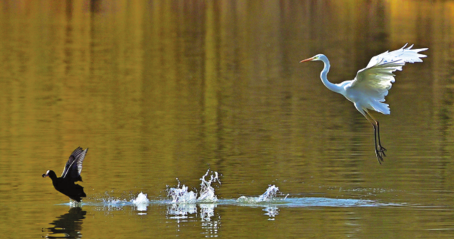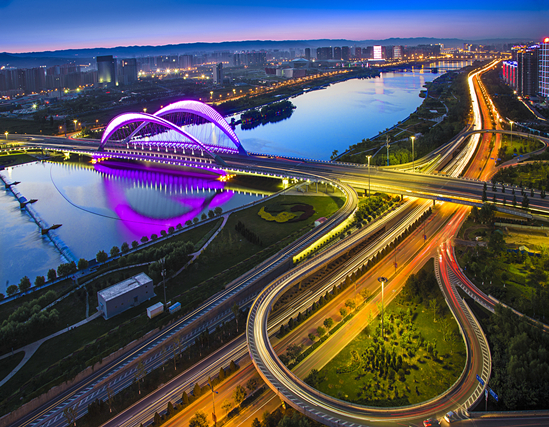Decades of work to clean up Fenhe River pays off
Updated: 2022-12-02

Migratory birds are spotted in Taiyuan's Fenhe Wetland Park. [Photo by Liu Tong for China Daily]
Duan Zhu, a resident in the Shanxi city of Taiyuan, has insisted on swimming in the Fenhe River for about 20 years, be it summer or winter.
The 69-year-old said that in the beginning, he used to swim in nearby ponds with a better water quality and never dared do that in the river.
"The period spanning the 1980s and 90s was the worst time for the Fenhe," Duan said. "It was a dry river most of the year, or polluted with yellowish, stinky water."
He said the deterioration of the river was the result of pollution from the coal-related industries in nearby regions. "This was also evidenced by a landscape blackened by coal dust," he said. "The trees along the river and even the sparrows on the trees were black."
With a length of 713 kilometers, the Fenhe is the second-largest tributary of the Yellow River and is regarded as the "mother river of Shanxi".
It began to deteriorate in the 1970s, featuring substantial decreases in runoff volume and worsening water quality.
Taiyuan began to improve the river in 1998. Local resident Zhang Yuhong said she is a witness to the river's transformation, as she was working in the first phase of the river's improvement project that year.
"We started enhancing the embankment and dredging the riverbed," Zhang said. "Thousands of residents took part in the project as volunteers, wanting the river's environment to turn for the better as soon as possible."
The Fenhe began to have steady runoff in 2000, Zhang said. Efforts in controlling pollution, greening both banks and increasing the water supply have continued since.
In 2021, Taiyuan announced the completion of the comprehensive river improvement project. The 43-km section of the river has become an attractive scenic belt.
Improving the environment of the Fenhe River has been a province-wide campaign in Shanxi for decades.
The city of Linfen in the lower reaches of the Fenhe began large-scale improvements of the river in the early 2000s. The city did this by shutting down polluting enterprises and repairing the river's ecosystem.
Quwo county in Linfen is one of the beneficiaries of the river's improvement. A saline land of 170 hectares along the river has been turned into fertile ground for vegetable farming.
"The vegetable farming here generates more than 35 million yuan ($4.89 million) in net profit a year and brings steady revenue to local farmers," said Yang Xu, general manager of a company operating the farms.
Ningwu county in Xinzhou city is where the source of the Fenhe is. It was among the earliest in Shanxi to begin improving the river, according to Li Jianmin, an official engaged in the river's improvement for more than 30 years.
Li said the county began to improve the river in the 1980s, with efforts focusing on curbing pollution, harnessing soil erosion and increasing vegetation coverage.
"Over the past three decades, Ningwu has phased out a total of 511 polluting enterprises," Li said. "The forest coverage has increased from 23.9 percent in the 1980s to 45.4 percent at present."
The historical source of the Fenhe is the Leiming Temple spring in Ningwu. But today it has a new source. In Toumaying village, about 20 km from Leiming Temple, the runoff of the river sees substantial growth because of water released from a water diversion project originating in the Yellow River more than 100 km away.
The increased water supply to the river has made it a better habitat for both humans and wildlife. The Fenhe Scenic Belt in Taiyuan, for instance, is now home to about 160 bird species, according to bird-watchers.
Zhao Jianjun and Li Shu contributed to this story.



